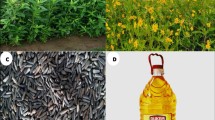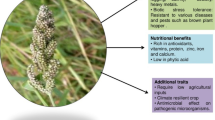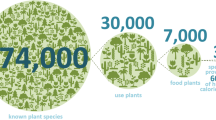Abstract
Niger (noug; Guizotia abyssinica) is an economically important edible oilseed crop. This review sought to demonstrate the significance of niger for sustainable food security in Ethiopia, where it is produced exclusively by smallholders. In addition to its edible oil, niger seed is an important source of proteins, carbohydrates, vitamins and fiber that significantly contribute to the human diet. The crop has a wide genetic basis that is reflected in the form of a high variation in desirable traits, including seed yield, seed oil content, seed oil quality and photoperiod sensitivity. However, the wealth of niger genetic diversity has so far remained largely unexploited and research efforts have not yet yielded satisfactory results in the form of new and superior cultivars. The recent molecular and nutritional quality studies coupled with pre-breeding work have opened up new opportunities for the improvement of niger. A high yielding niger cultivars with oil content of up to 60 % and/or oleic acid content of up to 70 % can easily be bred based on Ethiopian niger gene pool through the combined use of novel genomic tools, traditional breeding and farmer-participatory approaches. The improvement of niger will have a significant contribution towards Ethiopia’s food security and sustainable development in general and self-sufficiency in edible oil in particular. Overall, an investment in the niger improvement programs will likely be of benefit far beyond Ethiopia’s borders and could potentially lead to the expansion of the crop outside the regions where it is currently grown.

Similar content being viewed by others
References
Alemaw A, Teklewold A (1995) An agronomic and seed-quality evaluation of niger (Guizotia abyssinica Cass.) germplasm grown in Ethiopia. Plant Breed 114:375–376
Central Statistical Agency (CSA) (2009) Report on area and production of crops, agricultural sample survey 2008/2009. Statistical Bulletin 446, Addis Ababa
Central Statistical Agency (CSA) (2012) Report on area and production of major crops, agricultural sample survey 2011/2012. Statistical Bulletin, Addis Ababa
Dagne K (1994) Meiosis in interspecific hybrids and genomic interrelationships in Guizotia Cass. (Compositae). Hereditas 121:119–129
Dagne K (1995) Karyotypes, C-banding and nucleolar numbers in Guizotia (Compositae). Plant Syst Evol 195:121–135
Dagne K, Heneen WK (1992) The karyotype and nucleoli of Guizotia abyssinica (Compositae). Hereditas 117:73–83
Dagne K, Jonsson A (1997) Oil content and fatty acid composition of seeds of Guizotia Cass. (Compositae). J Sci Food Agric 73:274–278
Dehghani AA, Mohammadi ZB, Maghsoudlou Y, Mahoonak AS (2012) Intelligent estimation of the canola oil stability using artificial neural networks. Food Bioprocess Technol 5:533–540
Dempewolf H, Bordoni P, Riesberg L, Johannes E (2010a) Food security: crop species diversity. Science 328:169–170
Dempewolf H, Kane NC, Ostevik KL, Geleta M, Stewart ML, Lai Z, Bekele E, Cronk QCB, Rieseberg LH (2010b) Establishing genomic tools and resources for Guizotia abyssinica (L.f.) Cass.—the development of a library of expressed sequence tags, microsatellite loci and the sequencing of its chloroplast genome. Mol Ecol Resour 10:1048–1058
Devereux S (2009) Why does famine persist in Africa? Food Secur 1:25–35
Dutta PC, Helmersson S, Kebedu E, Alemaw G (1994) Variation in lipid composition of niger seed (Guizotia abyssinica Cass.) samples collected from different regions in Ethiopia. J Am Oil Chem Soc 71:839–843
Geleta M (2007) Genetic diversity, phylogenetics and molecular systematics of Guizotia Cass. (Asteraceae). PhD thesis, Swedish University of Agricultural Sciences, Department of Plant Protection Biology
Geleta M, Bryngelsson T (2010) Population genetics of self-incompatibility and developing self-compatible genotypes in Guizotia abyssinica (L. f.) Cass. (Asteraceae). Euphytica 176:417–430
Geleta M, Asfaw Z, Bekele E, Teshome A (2002) Edible oil crops and their integration with the major cereals in North Shewa and South Welo, central highlands of Ethiopia: an ethnobotanical perspective. Hereditas 137:29–40
Geleta M, Bryngelsson T, Bekele E, Dagne K (2007a) AFLP and RAPD analyses of genetic diversity of wild and/or weedy Guizotia (Asteraceae) from Ethiopia. Hereditas 144:53–62
Geleta M, Bryngelsson T, Bekele E, Dagne K (2007b) Comparative analysis of genetic relationship and diagnostic markers of several taxa of Guizotia Cass. (Asteraceae) as revealed by AFLPs and RAPDs. Plant Syst Evol 265:221–239
Geleta M, Bryngelsson T, Bekele E, Dagne K (2007c) Genetic diversity of Guizotia abyssinica (L. f.) Cass. (Asteraceae) from Ethiopia as revealed by random amplified polymorphic DNA (RAPD). Genet Resour Crop Evol 54:601–614
Geleta M, Bryngelsson T, Bekele E, Dagne K (2008) Assessment of genetic diversity of Guizotia abyssinica (L.f.) Cass. (Asteraceae) from Ethiopia using amplified fragment length polymorphism (AFLP). Plant Genet Resour 6:41–51
Geleta M, Bryngelsson T, Bekele E, Dagne K (2010) Phylogenetics and taxonomic delimitation of the genus Guizotia (Asteraceae) based on sequences derived from various chloroplast DNA regions. Plant Syst Evol 289:77–89
Geleta M, Stymne S, Bryngelsson T (2011) Variation and inheritance of oil content and fatty acid composition in niger (Guizotia abyssinica). J Food Comp Anal 24:995–1003
Getinet A, Sharma SM (1996) Niger (Guizotia abyssinica (L. f.) Cass. Promoting the conservation and use of underutilized and neglected crops. vol 5. Institute of Plant Genetics and Crop Plant Research, Gatersleben/International Plant Genetic Resources Institute, Rome
Hawkes JG (1983) The diversity of crop plants. Harvard University Press, Cambridge
IOPEPC (2012) Indian oilseeds and produce export promotion council. http://www.iopepc.org/Indian%20Oilseed%20Production.pdf
Javidfar F, Ripley VL, Roslinsky V, Zeinali H, Abdmishani C (2006) Identification of molecular markers associated with oleic and linolenic acid in spring oilseed rape (Brassica napus). Plant Breed 125:65–71
Kandel HJ, Porter PM, Johnson BL, Henson RA, Hanson BK, Weisberg S, LeGare DG (2004) Plant population influences niger seed yield in the Northern Great Plains. Crop Sci 44:190–197
Mensink RP, Temme EH, Hornstra G (1994) Dietary saturated and trans fatty acids and lipoprotein metabolism. Ann Med 26:461–464
Mokrani L, Gentzbittel L, Azanza F, Fitamant L, Al-Chaarani G, Sarrafi A (2002) Mapping and analysis of quantitative trait loci for grain oil content and agronomic traits using AFLP and SSR in sunflower (Helianthus annuus L.). Theor Appl Genet 106:149–156
Monteros MJ, Burton JW, Boerma HR (2008) Molecular mapping and confirmation of QTLs associated with oleic acid content in N00–3350 soybean. Crop Sci 48:2223–2234
Murthy HN, Hiremath SC, Salimath SS (1993) Origin, evolution and genome differentiation in Guizotia abyssinica and its wild species. Theor Appl Genet 87:587–592
Nemomissa S, Bekele E, Dagne K (1999) Self-incompatibility system in Ethiopian populations of Guizotia abyssinica (L.f.) Cass. (niger). Sinet Ethiop J Sci 22:67–88
Petros Y, Merker A, Zeleke H (2007) Analysis of genetic diversity of Guizotia abyssinica from Ethiopia using inter simple sequence repeat markers. Hereditas 144:18–24
Petros Y, Carlsson AS, Stymne S, Zeleke H, Fält A-S, Merker A (2009) Developing high oleic acid in Guizotia abyssinica (L.f.) Cass. by plant breeding. Plant Breed 128:691–695
Pradhan K, Mishra RC, Paikary RK (1995) Genetic variability and character association in niger. Indian J Genet 55:457–459
Ramadan MF, Mörsel J-T (2004) Oxidative stability of black cumin (Nigella sativa L.), coriander (Coriandrum sativum L.) and niger (Guizotia abyssinica Cass.) crude seed oils upon stripping. Eur J Lipid Sci Tech 106:35–43
Riley KW, Belayneh H (1989) Niger. In: Robbelen G, Downey RK, Ashri A (eds) Oil crops of the world, their breeding and utilization. McGrow-Hill, New York, pp 394–403
Seegeler CJP (1983) Oil plants in Ethiopia their taxonomy and agricultural significance. Center of Agricultural Publishing and Documentation, Wageningen
Singh B, Patra GJ (1989) Character association and path coefficients of quantitative traits in niger (Guizotia abyssinica). Indian J Agric Sci 59:442–445
Thatte P, Lakshmi AJ (2012) Nutritional potential, bioaccessibility of minerals and antioxidant properties of niger (Guizotia abyssinica cass.) seed protein. Int J Food Sci Tech 47:656–663
Urie L (1985) Inheritance of high oleic acid in sunflower. Crop Sci 25:986–989
Vollmann J, Rjcan I (2010) Oil crop breeding and genetics. In: Vollmann J, Rjcan I (eds) Oil crops. Springer, Dordrecht, pp 1–30
Wanasundara UN, Shahidi F (1994) Canola extract as an alternative natural antioxidant for canola oil. J Am Oil Chem Soc 71:817–822
Weiss EA (1983) Oil seed crops. Longman Inc., New York
Wijnands J, Biersteker J, Hiel R (2007) Oilseeds business opportunities in Ethiopia. Ministry of Agriculture, Nature and Food Quality, The Netherlands
Acknowledgments
The research work on niger at Swedish University of Agricultural Sciences (SLU) has been financed by the Swedish International Development Agency (SIDA), the Nilsson-Ehle Foundation, the Einar and Inga Nilsson fund, and Strategic Grants from the LTJ Faculty, SLU (SS) to which the authors of this review are highly grateful.
Author information
Authors and Affiliations
Corresponding author
Rights and permissions
About this article
Cite this article
Geleta, M., Ortiz, R. The importance of Guizotia abyssinica (niger) for sustainable food security in Ethiopia. Genet Resour Crop Evol 60, 1763–1770 (2013). https://doi.org/10.1007/s10722-013-9997-9
Received:
Accepted:
Published:
Issue Date:
DOI: https://doi.org/10.1007/s10722-013-9997-9




